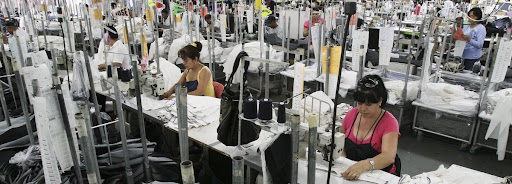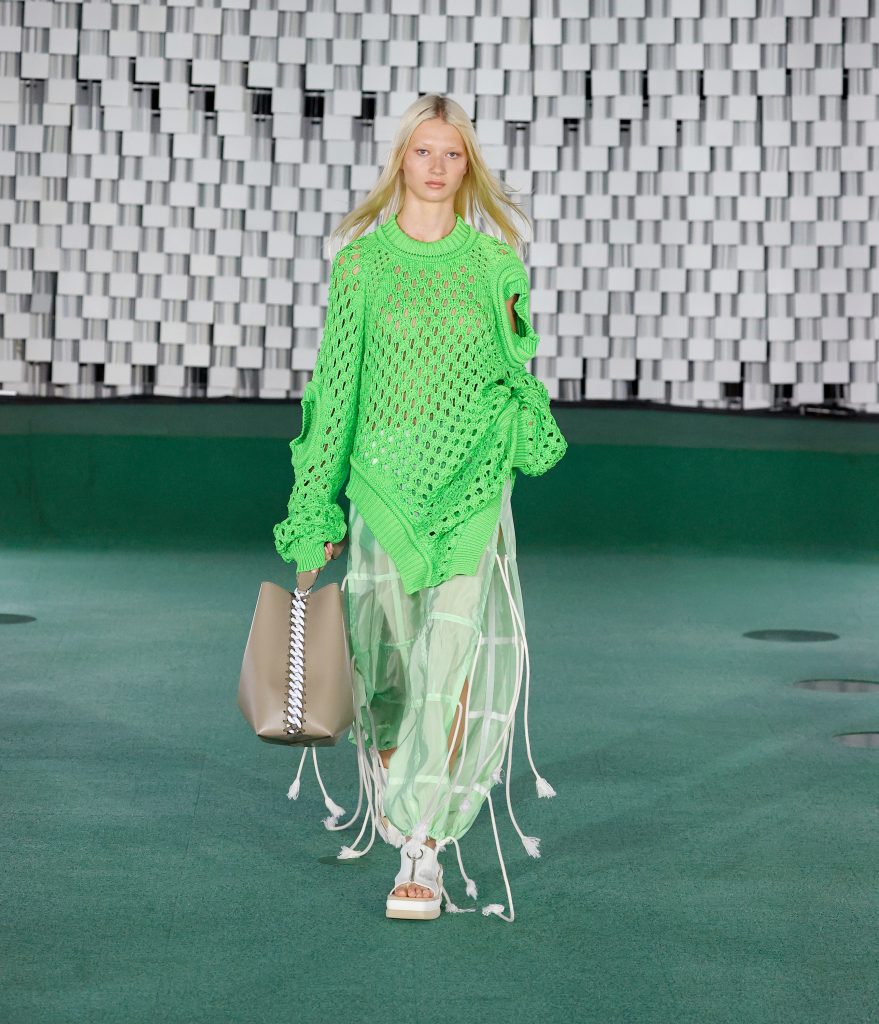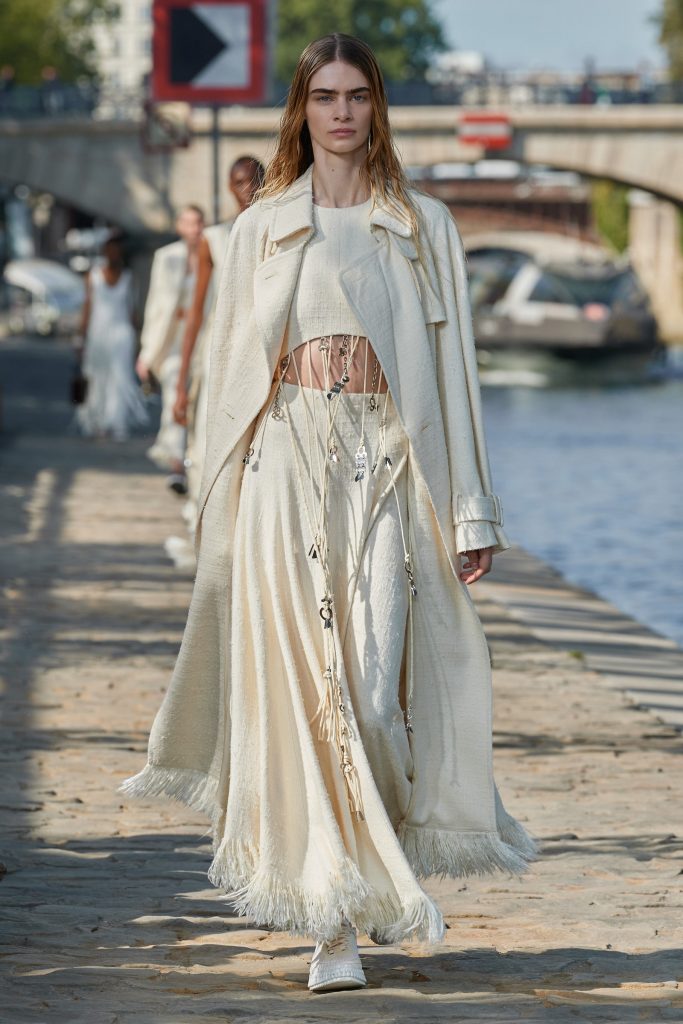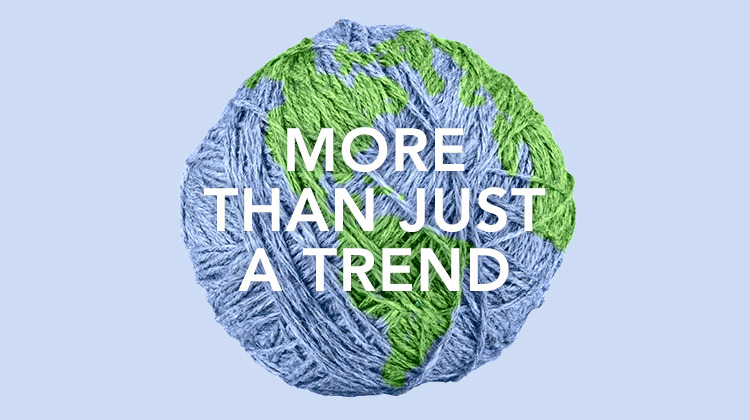Stella McCartney Winter 19 CampaignCourtesy of Stella McCartney. (Photo Credit: Stella McCartney)
At the University of Fashion we want to start by wishing everyone a Happy New Year!
As we leave behind the uncertainty of 2021 (with the rise of Covid-19’s latest strand: Omicron), we want to focus on the positive. Moving forward, the fashion industry is taking new strides in sustainability and focusing on greener methods to produce fashion. While our industry may get a bad rap from environmentalists, there were plenty of sustainable wins this year that fashion companies should focus on, including bolstering garment worker rights, as well as strides in the circular fashion space — steered by bio-based material innovators, luxury companies, pre-owned vendors and systems thinkers alike.
Labor Rights Became Something to Shout About

Garment Center workers. (Photo Credit: Garmentworkeract)
2021 marked a hard-earned triumph for garment workers and ethical business allies in California with the signing of the Garment Worker Protection Act (known as SB 62) into law this past September.
The bill takes a jab at the industry’s high rates of wage theft and sub-minimum pay, by first eliminating the piece-rate system of compensation, while closing a prior loophole in the original legislation that let fashion labels avoid responsibility for their supply chains. Under this groundbreaking new law, joint liability will exist, so fashion companies, subcontractors, and workers are all included in the negotiating process.
According to WWD, the law’s passage is far-reaching, and by some experts, it ushers in a new sustainable era for fashion and a chance to shift the power balance.
“Over the past 20 years, fashion has changed.…Labor laws become obsolete because the economic structure of that industry has changed,” according to Victor Narro, project director and professor of Labor Studies at the University of California Los Angeles Labor Center. Narro was on the team that drafted California’s landmark worker protection law in 1999.
Fashion is constantly changing and so far more than 140 fashion brands (among them Reformation, Boyish, Mara Hoffman, Eileen Fisher) have been threads of change (no pun intended).
California is home to the biggest garment manufacturing hub in the U.S. and counts for over 45,000 garment industry workers. According to WWD, the majority of the garment industry workforce are highly skilled women of color (averaging 20 years of experience), fueling brands like Fashion Nova, Forever 21, Windsor, Charlotte Russe, Urban Outfitters and Lulus. All of which were named as “top violators” in wage theft cases according to SB 62 bill co-sponsor the Garment Worker Center.
“I would say that I think that the bill is bordering on revolutionary, not just for garment workers, but also other low-wage workers in farming and agriculture,” said Ngozi Okaro, executive director of Custom Collaborative, a New York City-based workforce development nonprofit and social enterprise. “What’s important is it drills down to holding everyone along the value chain responsible.”
Safety for Garment Workers

ACCORD on Fire and Building Safety in Bangladesh. (Photo Credit: Apparel Insider)
In another extensive and time-sensitive move for garment worker protection, The Bangladesh Accord on Fire Building Safety saw a last-ditch revision in The International Accord for Health and Safety in the Textile and Garment Industry.
As of December 2021, the International Accord totals 155 brand signatories (just shy of the 200 signatories for the original document) with H&M, Inditex, Bestseller and C&A among the first to sign. The purpose of the International Accord is to expand health and safety coverage for factory garment workers in Bangladesh, as well as other high-risk sourcing countries in the South Asian territories.
In 2021, many brands rushed to pen their support for sustainable causes. Many fashion labels including Everlane, ThredUp, Rebecca Minkoff, Allbirds, Reformation and more signed a letter to U.S. President Joe Biden to appoint a “fashion czar”; while in the U.K., similar calls echoed out for a “garment trade adjudicator”.
So, it is clear that 2021 was the year the fashion industry moved forward in their intent for advancing social and environmental progress.
Resale Momentum

The 2018 campaign for Vestiaire Collective. (Photo Credit: Vestiaire Collective)
“Buying a pre-loved handbag from the same brand’s online store that you bought a new pair of boots from is going to be a billion-dollar game changer for the fashion community,” said The RealReal’s former director of business development, Karin Dillie, who went from Sotheby’s, The RealReal, to now, brand-owned resale space at Recurate, in an interview with WWD.
Last year, direct-to-consumer fashion brands like Boyish Jeans, Coclico Shoes and Époque Évolution, partnered with branded business-to-consumer marketplace Treet, while Cuyana, Vera Bradley and Fabletics partnered with ThredUp.
Kering announced a $216 million investment in Vestiaire Collective in March of 2021. Richemont rolled out resale partnerships (via Watchfinder) at Net-a-porter and Mr Porter in July. By August, new collaborations were forged in-store and online, one highlight being luxury pre-owned vendor Fashionphile teaming up with Neighborhood Goods.
The athletic brand New Balance launched its “New Balance Renewed” program with The Renewal Workshop. H&M newly launched its own “Rewear” resale marketplace in Canada, and URBN announced its “Nuuly Thrift” platform in fall 2021.
Throughout the pandemic, the luxury resale market gained momentum while used goods piled up as people had time to purge their closets.
Innovation in Sustainability

Stella McCartney’s new bag made with Mylo. (Photo Credit: Vegnews)
Sustainability innovation has definitely ramped up and has become a BIG movement within the fashion industry. Throughout 2021, giant fashion and athletic brands including Adidas, Nike, H&M, Stella McCartney, Ralph Lauren, Patagonia, and Gap, to name a few, have looked to nature and have invested in buzzy next-gen materials.
“There are exciting innovations for clothing production that are designed to have less of an environmental impact after its intended use; for example, fibers and fabrics designed to: be collected and mechanically or chemically recycled back into new textiles; biodegrade (under specific conditions); or compost into non-toxic constituents,” Barbara Martinez, open innovation director at Conservation X Labs, a technology and innovation hub based in Washington, D.C., told WWD.
A September report from nonprofit Material Innovation Initiative and consumer research firm North Mountain Consulting tallied $1.29 billion invested in standout material innovation firms from 2015 to May 2021. MII found that vegan leather alone could command 54 percent of the market, according to Nicole Rawling, cofounder and chief executive officer of the Material Innovation Initiative. “The findings reveal that cost-competitive next-gen materials could command the majority of many markets,” she said in an interview with WWD.
Even luxury designers are looking to vegan leather options. Case-in-point, Hermès, a house immersed in tradition, shocked the luxury world when it announced a partnership with the California-based start-up MycoWorks to develop a leather-type material out of mycelium – this would be the first time the luxury label stepped away from the houses’ signature calfskin leather of its renowned Birkin and Kelly bags.
Stella McCartney, one of the first luxury designers to focus on sustainability, has been experimenting with fungi as well. This past year, the fashion house has partnered with Bolt Threads in developing Mylo, a new trademarked material made from the root system of fungi.
McCartney introduced a mushroom leather bag during her spring 2022 show, which began with a voice stating that “In fashion, mushrooms are the future,” across its Paris venue. The designer’s goal is to offer the innovative material to other brands and help bring the use of sustainable materials into mainstream fashion.
Luxury, Resale Boast B Corp Chops

At Chloé, Gabriela Hearst trimmed dresses with metal “talismans” sourced from deadstock jewelry supplies. (Photo Credit Vogue: Runway)
Fashion brands (both luxury and mass) are often criticized for the fast pace of their production calendars, hosting shows in exotic locations, and having little visibility in their massive supply chains.
But in the past few years, many brands are taking sustainability seriously by reaching for a new title-grab. 2021 was the pathfinding year when luxury fashion houses (including luxury resellers) bought into B Corp status.
The Benefit Corporation (abbreviated as B Corp) is regarded as the “gold standard” in sustainable companies; the certification is provided by nonprofit B Lab, when companies showcase that they can fulfill its strict ESG criteria. B Corps are legally bound to act in the interest of both people and out planet.
This past September, Kering-backed Vestiaire Collective led the way as the first in resale to earn B Corp status. Richemont-owned Chloé was the first luxury fashion house to receive the much-acclaimed certification, setting a new standard of how brands should operate moving forward in the fashion industry.
“Beyond the fact that we are proud of it as a company, we also aim to inspire many others to join,” said Riccardo Bellini, chief executive officer of the Compagnie Financière Richemont-owned brand, to WWD. “We upgraded our operations, governance and policies in a way that allows us to operate in a more environmentally and socially responsible manner.”
Chloé began moving to a purpose-driven business model before the pandemic and with the appointment of Gabriela Hearst (named creative director in December 2020), whose entire design philosophy revolves around environmentally friendly practices. Some of the policies Chloé implemented along the way included its “Women Forward for a Fairer Future” mission statement; the appointment of an advisory board of experts; as well as the inclusion of more social entrepreneurs in its supply chain.
Richemont’s Bellini summed up the B Corp differential best: “It’s all about the mindset of continuously challenging ourselves to improve, and to bring the full equation of financial, social and environmental value to the table in every decision we make.”

Sustainable fashion is more than just a trend. (Photo Credit: Girotti Shoes)
Be sure to check out UoF’s lessons on sustainability: Introduction to Sustainable Fashion Design, Sustainable Materials For Fashion Design,
Designing, Producing & Marketing a Sustainable Collection, Sustainable Fashion Designer – Monisha Raja
Eco-Textiles, and Sustainable Fashion Designer – Kristen Luong,
So tell us, how will you create a more sustainable brand moving forward?
-------------------------------------
By: Antonia Sardone
Title: RINGING IN 2022 WITH A NEW FOCUS ON SUSTAINABILITY
Sourced From: www.universityoffashion.com/blog/ringing-in-2022-with-a-new-focus-on-sustainability/
Published Date: Sun, 02 Jan 2022 23:55:09 +0000
Read More
 FestivalsMusicNew ReleasesArtistsFashion & ClothingVideosPrivacy PolicyTerms And Conditions
FestivalsMusicNew ReleasesArtistsFashion & ClothingVideosPrivacy PolicyTerms And Conditions
